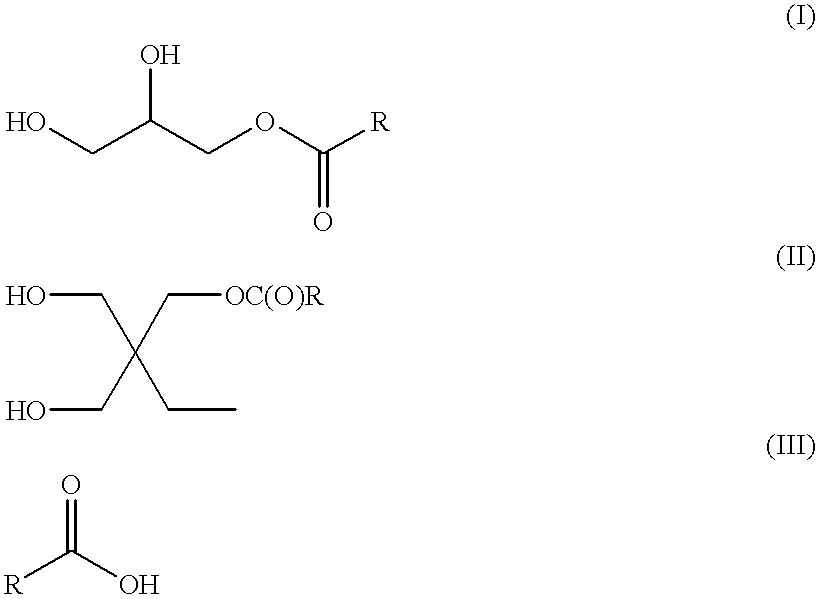Acrylic modified waterborne alkyd or uralkyd dispersions
a technology dispersions, applied in the field of acrylic modified waterborne alkyds or uralkyd dispersions, can solve the problems of solvent-borne, solvent-borne, alkyds or uralkyds not receiving much attention, and the relative slow "dry" and/or cure time is not good
- Summary
- Abstract
- Description
- Claims
- Application Information
AI Technical Summary
Problems solved by technology
Method used
Image
Examples
examples 1-8
Preparation of KELSOL Alkyd / acrylic Hybrids
A series of alkyd / acrylic hybrids was prepared using the KELSOL dispersible alkyd resins shown in Table 1. The hybrids differ in LOF level, alkyd level, and alkyd type.
A general procedure for the preparation of these materials is as follows: To a 500 ml reactor, appropriate amounts of demineralized water and alkyd were added, along with sufficient ammonium hydroxide to adjust to pH 8.0. These reactor contents were heated to 82.degree. C. at which time 2.06 g Dowfax 2A1 (sodium dodecyl diphenyloxide disulfonate available from Dow Chemical) and 0.93 g ammonium persulfate in 22 g water was added to the reactor over 240 minutes. Simultaneously, 176 g of the monomer mixture shown in Table 18 was added over 225 minutes. At the end of the 225 minutes, 9 g of methyl methacrylate was added over 15 minutes. After completion of the additions, the reactor was held at 82.degree. C. for one hour, then cooled to room temperature. Finally, 0.2 g of tert-bu...
example 9
Film Gel Fractions and Film Swell Ratios of Examples 1-8
For each latex of Examples 1-8, to 50 g latex was added 0.32 g of 28% ammonium hydroxide, 2.7 g of a 25% aqueous solution of TERGITOL 15-S-40, 1.1 g of TEXANOL, and 0.45 g of Cobalt HYDROCURE II. Films were cast and air dried at room temperature for one week. Film gel fractions (FGF) and film swell ratios (FSR) were determined as above, except using tetrahydrofuran (THF) as the solvent instead of acetone. The results are summarized in Table 3.
example 1
as the non-functional control had a much higher FSR and a much lower FGF than the systems containing AAEM as the LOF. Example 3 which had the highest level of LOF had the lowest FSR and the highest FGF.
TABLE 3 Film Swell Ratios and Film Gel Fractions of Examples 1-8 Latex Example Film Swell Ratio Film Gel Fractions 1 33.9 0.36 2 8.7 0.80 3 3.9 0.89 4 6.6 0.81 5 6.3 0.82 6 17.1 0.57 7 15.3 0.62 8 9.2 0.76
PUM
| Property | Measurement | Unit |
|---|---|---|
| wt % | aaaaa | aaaaa |
| size | aaaaa | aaaaa |
| particle size | aaaaa | aaaaa |
Abstract
Description
Claims
Application Information
 Login to View More
Login to View More - R&D
- Intellectual Property
- Life Sciences
- Materials
- Tech Scout
- Unparalleled Data Quality
- Higher Quality Content
- 60% Fewer Hallucinations
Browse by: Latest US Patents, China's latest patents, Technical Efficacy Thesaurus, Application Domain, Technology Topic, Popular Technical Reports.
© 2025 PatSnap. All rights reserved.Legal|Privacy policy|Modern Slavery Act Transparency Statement|Sitemap|About US| Contact US: help@patsnap.com


